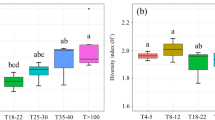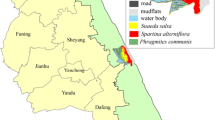Abstract
Strip-mining operations greatly disturb soil, vegetation and landscape elements, causing many ecological and environmental problems. Establishment of vegetation is a critical step in achieving the goal of ecosystem restoration in mining areas. At the Shouyun Iron Ore Mine in suburban Beijing, China, we investigated selective vegetation and soil traits on a tailings dam 7 years after site treatments with three contrasting approaches: (1) soil covering (designated as SC), (2) application of a straw mat, known as “vegetation carpet”, which contains prescribed plant seed mix and water retaining agent (designated as VC), on top of sand piles, and (3) combination of soil covering and application of vegetation carpet (designated as SC+VC). We found that after 7 years of reclamation, the SC+VC site had twice the number of plant species and greater biomass than the SC and VC sites, and that the VC site had a comparable plant abundance with the SC+VC site but much less biodiversity and plant coverage. The VC site did not differ with the SC site in the vegetation traits, albeit low soil fertility. It is suggested that application of vegetation carpet can be an alternative to introduction of topsoil for treatment of tailings dam with fine-structured substrate of ore sands. However, combination of topsoil treatment and application of vegetation carpet greatly increases vegetation coverage and plant biodiversity, and is therefore a much better approach for assisting vegetation establishment on the tailings dam of strip-mining operations. While application of vegetation carpet helps to stabilize the loose surface of fine-structured mine wastes and to introduce seed bank, introduction of fertile soil is necessary for supplying nutrients to plant growth in the efforts of ecosystem restoration of mining areas.



Similar content being viewed by others
References
Alday JG, Marrs RH, Martínez-Ruiz C (2011a) Vegetation convergence during early succession on coal wastes: a 6-year permanent plot study. Journal of Vegetation Science 22:1072–1083
Alday JG, Marrs RH, Martínez-Ruiz C (2011b) Vegetation succession on reclaimed coal wastes in Spain: the influence of soil and environmental factors. Applied Vegetation Science 14:84–94
Alday JG, Pallavicini Y, Marrs RH, Martínez-Ruiz C (2011c) Functional groups and dispersal strategies as guides for predicting vegetation dynamics on reclaimed mines. Plant Ecology 212:1759–1775
Allen EB, Covington WW, Falk DA (1997) Developing the conceptual basis for restoration ecology. Restoration Ecology 5:275–276
Baasch A, Kirmer A, Tischew S (2012) Nine years of vegetation development in a postmining site: effects of spontaneous and assisted site recovery. Journal of Applied Ecology 49:251–260
Bai YF, Han XG, Wu JG, Chen ZZ, Li LH (2004) Ecosystem stability and compensatory effects in the Inner Mongolia grassland. Nature 431:181–184
Bakker J, Berendse F (1999) Constraints in the restoration of ecological diversity in grassland and heathland communities. Tree 14:63–68
Bao SD (2000) Soil and agriculture chemistry analysis. China Agriculture Press, Beijing
Bradshaw AD (2000) The use of natural processes in reclamation-advantages and difficulties. Landscape Urban Plan 51:89–100
Bradshaw AD, Chadwick MJ (1980) The restoration of land: the ecology and reclamation of derelict and degraded land. Blackwell Scientific Publication, Oxford
Bradshaw AD, Hǘttl RF (2001) Future minesite restoration involves a broader approach. Ecological Engineering 17:87–90
Bryan LF, Cheryl AM, Kane RK, Todd AA, Erin JQ, Kelly K (2007) Restoration of prairie community structure and ecosystem function in an abandoned hayfield: a sowing experiment. Restoration Ecology 15:652–661
Burke A (2007) Recovery in naturally dynamic environments: a case study from the Sperrgebiet, Southern African arid succulent karoo. Environmental Management 40:635–648
Cooke JA, Johnson MS (2002) Ecological restoration of land with particular reference to the mining of metals and industrial minerals: a review of theory and practice. Environmental Reviews 10:41–71
Correll O, Isselstein J, Pavlu V (2003) Studying spatial and temporal dynamics of sward structure at low stocking densities: the use of an extended rising-plate-meter method. Grass and Forage Science 58:450–454
Cullen WR, Wheater CP, Dunleavy PJ (1998) Establishment of species-rich vegetation on reclaimed limestone quarry faces in Derbyshire, UK. Biological Conservation 84:25–33
Curtis JT (1959) The vegetation of Wisconsin, an ordination of plant communities. University Wisconsin Press, Madison
Dobson AP, Bradshaw AD, Baker AJM (1997) Hopes for the future: restoration ecology and conservation biology. Science 277:515–522
Fang JY, Wang XP, Shen ZH, Tang ZY, He JS, Yu D, Jiang Y, Wang ZH, Zheng CY, Zhu JL, Guo ZD (2009) Methods and protocols for plant community inventory. Biodiversity Science 17:533–548
FAO–UNESCO (1988) FAO/UNESCO Soil Map of the World, revised legend. World Resources Report 60, FAO, Rome
Foley JA, Defries R, Asner GP, Barford C, Bonan G, Carpenter SR, Chapin FS, Coe MT, Daily GC, Gibbs HK, Helkowski JH, Holloway T, Howard EA, Kucharik CJ, Monfreda C, Patz JA, Prentice C, Ramankutty N, Snyder PK (2005) Global consequences of land use. Science 309:570–574
García-Palacios P, Maestre FT, Gallardo A (2011) Soil nutrient heterogeneity modulates ecosystem responses to changes in the identity and richness of plant functional groups. Journal of Ecology 99:551–562
Guo HX, Wu DR, Zhu HX (1989) Land restoration in China. Journal of Applied Ecology 26:787–792
Guo XY, Zhang JT, Gong HL, Zhang GL, Dong Z (2005) Analysis of changes of the species diversity in the process of vegetation restoration in Antaibao mining field, China. Acta Ecologica Sinica 25(4):763–770
Hobbs RJ, Norton DA (1996) Towards a conceptual framework for restoration ecology. Restoration Ecology 4:93–110
Hodačová D, Prach K (2003) Spoil heaps from brown coal mining: technical reclamation versus spontaneous revegetation. Restoration Ecology 11:385–391
Hofmann M, Kowarsch N, Bonn S, Isselstein J (2001) Management for biodiversity and consequences for grassland productivity. Grassland Science 6:113–116
Holmes PM (2001) Shrubland restoration following woody alien invasion and mining: effects of topsoil depth, seed source, and fertilizer addition. Restoration Ecology 9:71–84
Jackson ML (1958) Soil chemical analysis. Prentice Hall, Englewood Cliffs
Jones HP, Schmitz OJ (2009) Rapid recovery of damaged ecosystems. PLoS One 4:1–6
Kimmerer RW (1984) Vegetation development on a dated series of abandoned lead and zinc mines in Southwestern Wisconsin. American Midland Naturalist 111:332–341
Kirmer A, Tischew S, Ozinga WA, von Lampe M, Baasch A, van Groenendael JM (2008) Importance of regional species pools and functional traits in colonization processes: predicting re-colonization after large-scale destruction of ecosystems. Journal of Applied Ecology 45:1523–1530
Kullu B, Behera N (2011) Vegetational succession on different age series sponge iron solid waste dumps with respect to top soil application. Research Journal Environment Earth Science 3:38–45
Kundu NK, Ghosh MK (1994) Studies on the topsoil of an underground coal-mining project. Environmental Conservation 21:126–132
Li MS (2006) Ecological restoration of mineland with particular reference to the metalliferous mine wasteland in China: a review of research and practice. Science of the Total Environment 357:38–53
Lin GCS, Ho SPS (2003) China’s resources and land-use change: insights from the 1996 land survey. Land Use Policy 20:87–107
Marriott CA, Bolton GR (1998) Changes in species composition of ungrazed, unfertilised swards after imposing seasonal cutting treatments. Grassland Science 3:465–468
Marriott CA, Bolton GR, Fisher JM (2003) Changes in species composition of abandoned sown sward after imposing seasonal cutting treatments. Grass and Forage Science 58:37–49
Melanie AN, John MK, Carl DG, Tim KM, Samuel CW (2006) Vegetation succession after bauxite mining in Western Australia. Restoration Ecology 14:278–288
Miao Z, Marrs R (2000) Ecological restoration and land reclamation in open-cast mines in Shanxi Province, China. Journal of Environmental Management 59:205–215
Nelson DW, Sommers LE (1982) Total carbon, organic carbon, and organic matter. In: Page AL, Miller RH, Keeney DR (eds) Methods of soil analysis. American Society of Agronomy and Soil Science Society of American, Madison
Pandey S, Maiti TK (2008) Physicochemical and biological characterization of slag disposal site at Burnpur, West Bengal. Pollution Research 27:345–348
Pavlu V, Hejcman M, Pavlu L, Gaisler J, Nežerková P, Andaluz MG (2005) Vegetation changes after cessation of grazing management in the Jizerské Mountains. Annales Botanici Fennici 42:343–349
Perrow MR, Davy AJ (eds) (2002) Handbook of ecological restoration. 1: Principles of restoration. Cambridge University Press, Cambridge
Pielou EC (1975) Ecological diversity. John Wiley, New York
Prach K, Pysek P (2001) Using spontaneous succession for restoration of human-disturbed habitats: experience from Central Europe. Ecology Engineering 17:55–62
Roy A, Basu SK, Singh KP (2002) Modeling ecosystem development on blast furnace slag dumps in a tropical region. Simulation 78:531–542
Ruiz-Jaen MC, Aide TM (2005) Restoration success: how is it being measured? Restoration Ecology 13:569–577
Shannon CE, Weiner W (1949) The mathematical theory of communication. Unknown distance function. The University of Illinois Press, Urbana
Shu WS, Ye ZH, Lan CY, Zhang ZQ, Wong MH (2001) Acidification of lead/zinc mine tailings and its effect on heavy metal mobility. Environment International 26:389–394
Ter Braak CJF, Šmilauer P (1998) CANOCO release 4. Reference manual and user’s guide to Canoco for Windows: Software for Canonical Community Ordination. Microcomputer Power, Ithaca
Tordoff GM, Baker AJ, Willis AJ (2000) Current approaches to the revegetation and reclamation of metalliferous mine wastes. Chemosphere 41:219–228
Wong MH (2003) Ecological restoration of mine degraded soils, with emphasis on metal contaminated soils. Chemosphere 50:775–780
Xia HP, Cai XA (2002) Ecological restoration technologies for mined lands: a review. Chinese Journal of Applied Ecology 13:1471–1477
Zedler JB (2007) Success: an unclear, subjective descriptor of restoration outcomes. Ecological Restoration 3:162–168
Zhao FY, Li JF, Cheng QX (2009) Niche characteristics of plant population under natural restoration on Shachang mining area in Beijing Shouyun Iron Ore. Science of Soil and Water Conservation 7:80–84
Zhou Y, He X, Xu J, Liu J (2009) Effects of coal mining subsidence on vegetation composition and plant diversity in semi-arid region. Acta Ecologica Sinica 29:4517–4525
Acknowledgments
This study was funded by a grant from the Beijing Municipal Commission of Education for development of Key Laboratory for Silviculture and Conservation. We thank Drs. Xiangdong Lei (Chinese Academy of Forestry) and Xiangcheng Mi (Institute of Botany, Chinese Academy of Sciences) for advice on statistical analysis, and two anonymous reviewers for constructive comments that greatly improved the manuscript.
Author information
Authors and Affiliations
Corresponding author
Rights and permissions
About this article
Cite this article
Yan, D., Zhao, F. & Sun, O.J. Assessment of Vegetation Establishment on Tailings Dam at an Iron Ore Mining Site of Suburban Beijing, China, 7 Years After Reclamation with Contrasting Site Treatment Methods. Environmental Management 52, 748–757 (2013). https://doi.org/10.1007/s00267-013-0092-y
Received:
Accepted:
Published:
Issue Date:
DOI: https://doi.org/10.1007/s00267-013-0092-y




